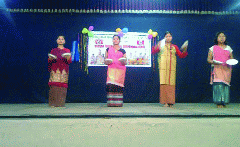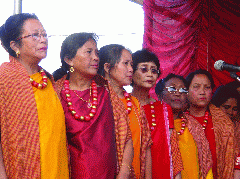Archives
Seng Kut Snem
It is upon these corner stones of philosophy that the Seng Khasi organisation emerged as the custodian of the spiritual, cultural and social heritage of the people of Ri Hynniewtrep land. It was during a turbulent period of history when the colonial rulers had set upon to trample upon the rights and beliefs of the people that sixteen youth having the grit and determination, set upon the building of the Seng Khasi bastion on November 23rd in the year 1899 for the preservation, promotion and propagation of the ancient wisdom and values which is a challenging task.
Seng Kut Snem day also marks the hallmark of Khasi renaissance being part of the nationalistic movement to  overthrow the foreign yoke, a continuation of the struggle when the king of the Khasi state of Hima Nongkhlaw U Tirot Sing Syiem attacked the British troops on April 4th in the year 1829 and also when the Jaintia war of independence was won further flared up when British soldiers desecrated a Khasi religious ceremony at Ialong near Jowai on December 30th in the year 1862. Seng Kut Snem is therefore part of the nationalistic aspirations of the Indian nation which began during the year 1857.
overthrow the foreign yoke, a continuation of the struggle when the king of the Khasi state of Hima Nongkhlaw U Tirot Sing Syiem attacked the British troops on April 4th in the year 1829 and also when the Jaintia war of independence was won further flared up when British soldiers desecrated a Khasi religious ceremony at Ialong near Jowai on December 30th in the year 1862. Seng Kut Snem is therefore part of the nationalistic aspirations of the Indian nation which began during the year 1857.
The Seng Khasi had adopted the traditional ancient symbol of the cock or rooster as its insignia having a mythological history of how, at one stage of time, the divine link of the people with their creator was lost because of the transgressions of humankind. An assembly of all creations then had chosen the most humble, that is to say the cock or rooster to intercede, as the sun had dimmed away, leaving the world in darkness, resulting in confusion of the mind and spirit.
 The cock and rooster undertook the challenging task of an emissary to plead with the divine for the return of the light of the sun – that the spiritual link between the creator and the creations would be restored once again. It was the qualities of humility, perseverance, dignity and diplomatic statesmanship of the cock or rooster that persuaded the love of the creator towards all creations, to concede to the appeal, that the light of the sun returned to the earth and that the spiritual link between the creator and the creations was restored. A covenant was then made that the cock or rooster would crow three times and that the light and brilliance of the sun would never fail to dawn in times of darkness, failures, uncertainties, adversaries, weakness of the mind, body and soul. The cock or rooster has thus become a symbol of humility and a promise of hope.
The cock and rooster undertook the challenging task of an emissary to plead with the divine for the return of the light of the sun – that the spiritual link between the creator and the creations would be restored once again. It was the qualities of humility, perseverance, dignity and diplomatic statesmanship of the cock or rooster that persuaded the love of the creator towards all creations, to concede to the appeal, that the light of the sun returned to the earth and that the spiritual link between the creator and the creations was restored. A covenant was then made that the cock or rooster would crow three times and that the light and brilliance of the sun would never fail to dawn in times of darkness, failures, uncertainties, adversaries, weakness of the mind, body and soul. The cock or rooster has thus become a symbol of humility and a promise of hope.
Another facet of the Seng Kut Snem, which is observed as the anniversary and thanks giving day is the year ending aspect. The Khasi calendar is based on the Almanac which is in turn based on the change of the four seasons, known indigenously as Saw Samoi, that is winter, spring, summer and autumn in accordance of crops sown and harvested during this period influenced by climatic changes, rain and phases of the moon.
It is therefore this period at the end of autumn and the onset of winter which is considered to be the close of the seasonal four seasons when crops especially paddy is being harvested. The beginning of the new year is marked by what the Khasis term as Soh thymmai – the ripening of new fruits such as oranges, citrus, sugarcane, ground fruits such as Sohphlang and others. People therefore pay homage to the creator for these bountiful gifts of Mother Earth that nature has provided.
Seng Kut Snem therefore marks the gratitude paid to the Divine Creator in thanksgiving ceremonies and at the same time invoking the blessings for a bountiful and prosperous new year ahead. The indigenous movement would therefore march forward according to the tenet of love for oneself and respect for others.
Sumar Sing Sawian

